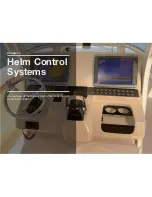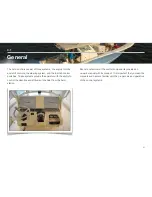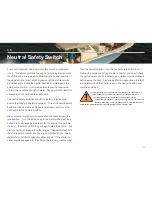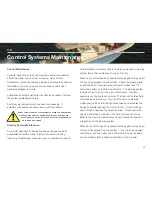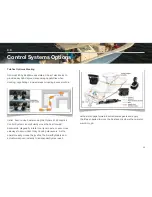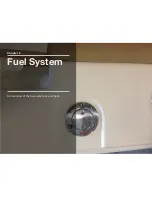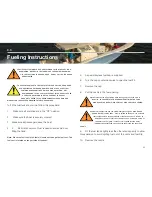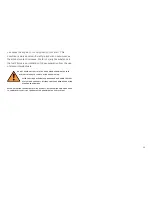
The gasoline fuel system used in Scout boats is designed to
meet or exceed the requirements of the U.S. Coast Guard, the
Boating Industry Association, and The American Boat and Yacht
Council in e
ff
ect at the time of manufacture.
All gasoline fuel systems have been factory inspected and
pressure tested in accordance with regulations in e
ff
ect at the
time of manufacture. This inspection assures that the system is
air tight, leak proof and safe. It is the responsibility of the
purchaser to maintain it in that condition. Make frequent
inspections to assure that no deterioration or loosening of
connections is resulting from vibration.
DO NOT LET THE ODOR OF GASOLINE GO UNCHECKED. ANY ODOR OF
GASOLINE MUST BE IMMEDIATELY INVESTIGATED AND STEPS TAKEN
TO PROTECT THE BOAT AND ITS OCCUPANTS UNTIL THE PROBLEM
IS CORRECTED. IF THE ODOR OF GASOLINE IS NOTED, SHUT OFF
ALL ENGINES AND ELECTRICAL EQUIPMENT. INVESTIGATE AND
CORRECT THE SITUATION IMMEDIATELY. HAVE ALL PASSENGERS PUT ON PERSONAL
FLOTATION DEVICES AND KEEP A FIRE EXTINGUISHER READY UNTIL THE SITUATION IS
RESOLVED.
Fuel Withdrawal Tubes
The fuel withdrawal tubes are positioned in the fuel tank to
achieve optimum fuel usage, fuel line routing, etc. At certain
speeds and hull trim angles, the fuel supply at the withdrawal
tank location can increase or decrease accordingly. Be
extremely careful when attempting to operate the boat when low
on fuel. Though some fuel may be in the tank, the relative trim
angle of the boat may cause the fuel to flow away from the
withdrawals.
Fuel Gauge
This indicates the amount of fuel in the tank. Due to the
mechanical nature of the fuel sender, variations in readings
during various speeds of operation may occur. This system is
merely a relative indication of the available fuel supply and not a
calibrated instrument.
4.1
General
32
Summary of Contents for 320 LXF
Page 1: ...320 LXF Scout Boats OWNER MANUAL ...
Page 2: ...Chapter 1 Owner s Information Warranty Certification and Boat Information ...
Page 11: ...Chapter 2 Propulsion A guide to your boat s propulsion system ...
Page 32: ...Chapter 4 Fuel System An overview of the fuel system of your boat ...
Page 40: ...Chapter 5 Electrical System An overview of the electrical system of your boat ...
Page 54: ...Chapter 6 Fresh Water System An overview of the fresh water system of your boat ...
Page 59: ...Chapter 7 Raw Water System An overview of the raw water system of your boat ...
Page 65: ...Chapter 8 Drainage System An overview of the drainage system of your boat ...
Page 70: ...Chapter 9 Ventilation System An overview of the ventilation system of your boat ...
Page 73: ...Chapter 10 Exterior Equipment An overview of the exterior equipment on your boat ...
Page 83: ...Chapter 11 Interior Equipment An overview of the interior equipment on your boat ...
Page 88: ...Chapter 12 Safety Equipment An overview of the safety equipment on your boat ...
Page 99: ...Chapter 13 Operation A general guide to operating your boat ...
Page 124: ...Chapter 14 Routine Maintenance A guide to keeping your boat running in good condition ...
Page 147: ...Chapter 16 Appendix Reference documents logs and schematics for your boat ...
Page 154: ...153 ...
Page 155: ...154 ...
Page 156: ...155 ...
Page 157: ...156 ...
Page 159: ...158 ...
Page 160: ...159 ...
Page 162: ...161 ...



